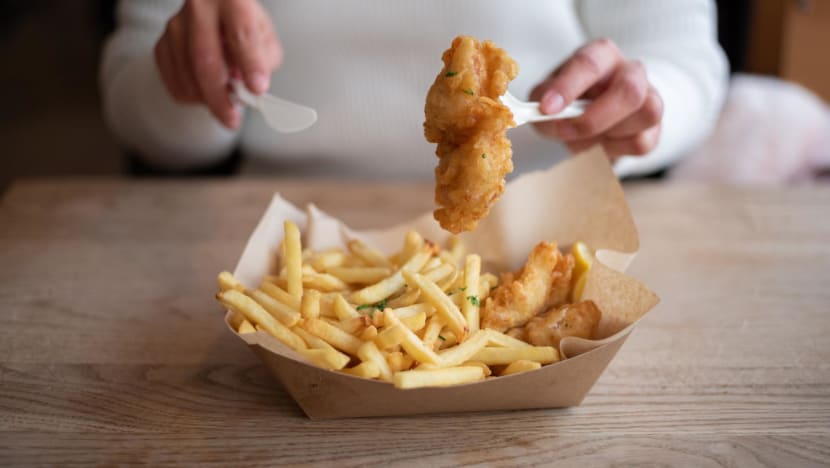Commentary: Food companies are vying to make the Impossible Beef of the sea
Alternative seafood products have the potential to dramatically reduce climate and food security pressures, but diners in Asia may not be sold yet, says Ryan Huling of the Good Food Institute APAC.

File photo of fish and chips. (Photo: iStock/hxyume)
SINGAPORE: Everywhere you look these days, new plant-based meats are being rolled out, from animal-free Whoppers at Burger King to plant-based chicken rice at Prive.
Despite it being early days for “alternative proteins”, consumers in Singapore and Southeast Asia are coming around to the idea that meat no longer has to be made from pigs, cows or chickens. But what about seafood?
Hong Kong-based startup OmniFoods, which sells alternative seafood products in Singapore and other major markets, has managed to get plant-based crab cakes and fish fillets offered at select Starbucks locations – a world first.
Conventional seafood companies like Thai Union – the world’s largest producer of canned tuna – have also enthusiastically leapt into the space, launching their own plant-based shrimp dumplings and fish nuggets.
Plant-based seafood may currently be a small slice of the alternative protein sector, but it has plenty of room to grow across Asian markets. Of the top 10 countries that eat the most fish, seven of them are in Asia, meaning that the pool of potential consumers for alternative seafood products is vast and deep.
WHY SWITCH TO ALTERNATIVE SEAFOOD
The climate and food safety motivations that drive many plant-based meat sales have clear parallels under the sea.
LISTEN - The Climate Conversations: Where will your fish come from in a climate stressed world?
While fish production may have a relatively lower climate impact compared to the gargantuan hoofprint of beef, research shows that the carbon dioxide emissions from bottom trawling – an industry practice in which weighted nets scrape the bottom of the ocean to catch aquatic animals – are comparable to the annual emissions from airplanes.
There is also growing international concern that consumer demand for seafood is outpacing species’ ability to replenish themselves, threatening food security. According to the Food and Agriculture Organization of the United Nations, one-third of commercial fish stocks are being harvested at unsustainable levels, and 90 per cent are being fully exploited.
Worldwide per capita fish consumption has accelerated faster than all other animal proteins, but is projected to slow down by 2030 because demand will outpace supply, especially in markets where overfishing is rife.
Alternative seafood products have the potential to alleviate these pressures and offer other advantages, like reduced risk of foodborne illness, an absence of microplastics and lack of contamination by mercury and other heavy metals.
ASIAN DINERS MIGHT NOT BE SOLD
The challenge? Asian consumers might not be sold yet.
According to a study commissioned by the Good Food Institute Asia Pacific (GFI APAC) on consumer perceptions of alternative seafood products, diners are curious about trying such dishes, but are sceptical that plant-based versions can deliver the “freshness” and “naturalness” that they believe conventional seafood does.
This wariness may come from the assumption that the freshest fish and crabs are dragged up from the sea every morning. But from a food safety standpoint, decoupling our protein supply from polluted waterways is a major plus.
When it comes to alternative seafood, GFI APAC’s research also shows that consumers in Asia will accept no compromises on taste, texture or health benefits for the sake of increased sustainability.
In other words, they will give plant-based seafood a closer look, but only if it delivers everything they already get from conventional seafood – a standard most consumers believe the sector has not yet achieved.
Additionally, alternative seafood producers still have a long way to go in tailoring their products to match a Southeast Asian’s palate. In the region, steamed fish is often eaten whole and crab meat straight out of the shell.
But plant-based versions have mostly appeared in the form of battered fish sticks and crab cakes, making them an uneven swap in traditional recipes. This will be one of the most critical areas for alternative protein producers to get right going forward, because the swiftest path to market success lies in meeting consumer preferences.
INVESTMENT POURING INTO ALTERNATIVE SEAFOODS
Still, this lengthy list of consumer demands has done little to slow interest in alternative seafood for food industry leaders, who no doubt envision the boatloads of cash they could haul in if they manage to craft the Impossible Beef of the sea.Investors are bullish on the potential of plant-based fish, with alternative seafood companies raising US$175 million in 2021 – nearly double the amount raised in 2020.
In total, more than 120 companies are now developing alternative seafood products around the world, including many in East and Southeast Asia. For example, Singapore-based Growthwell, which is backed by Temasek and other investors, recently outlined plans to export their alternative proteins, including seafood products made of konjac, to China and the UK.
As the old adage goes, “the customer is always right”. When it comes to alternative seafood, customers want products that can match or exceed the taste, texture, nutritional value and affordability of the conventional seafood they know and love.
These are not unreasonable requests, but satisfying them will require substantially more investment from public and private stakeholders into open-access research and development. These funds should go towards improving the quality, variety and cost of plant-based seafood products beyond what’s currently available.
For the sake of securing Asia’s increasingly fraught food supply and preserving the richness of our oceans amid a world of surging protein demand, we should all hope that alternative seafood producers can live up to consumers’ high expectations.
Ryan Huling is the senior communications manager of alternative protein think tank Good Food Institute APAC.



















